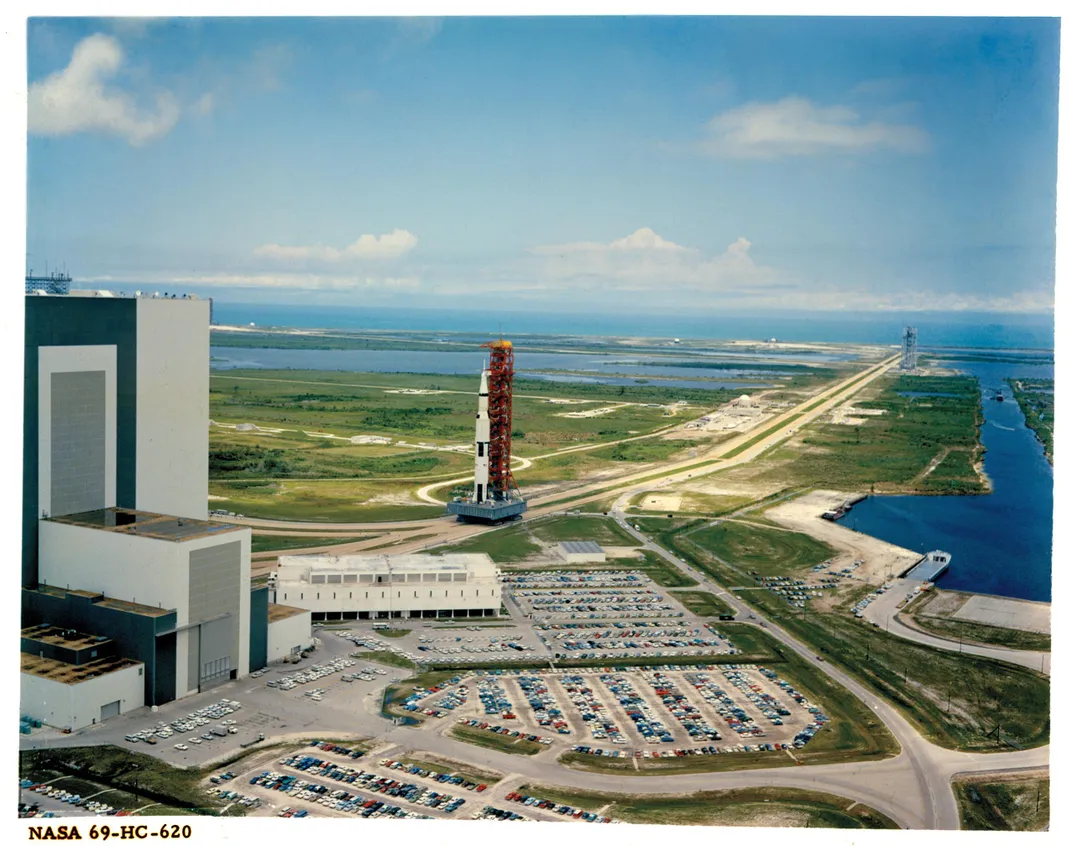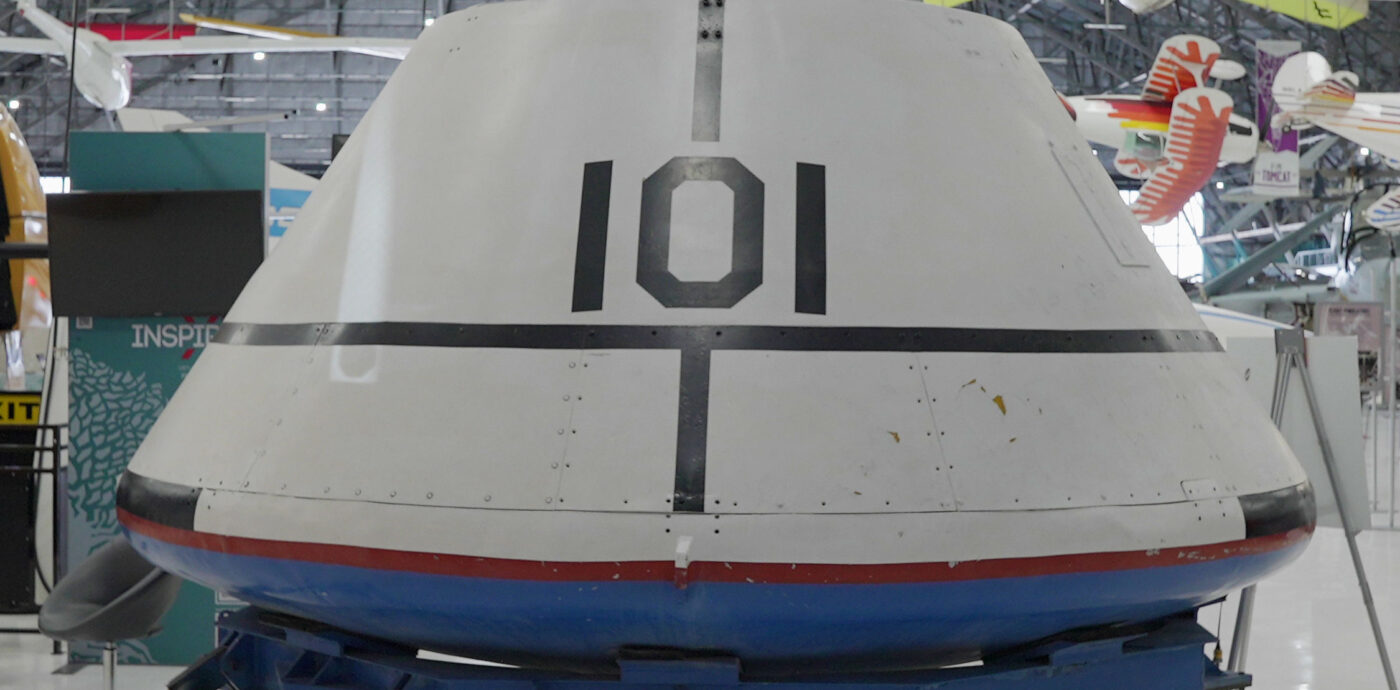Apollo 11 Model Aircraft Field - Visit us in Washington, DC and Chantilly, VA to discover hundreds of the world's most important aviation and historical attractions.
The trip to the moon and back required three very important spacecraft and technology, from the Saturn V rocket, to the Command Module, Columbia, and the Lunar Module, Eagle. Click the link below to learn more about every technology that puts an American on the Moon.
Apollo 11 Model Aircraft Field

Introduction Saturn V Command Module, Computer Lunar Module, Bag
Apollo 11: Fifty Years Since That One Small Step
When President Kennedy promised that the Americans would put a man on the moon by the end of the decade, no rocket could get there. The Saturn V rocket engine enabled astronauts to travel to the moon. For fifty years, the Saturn V was the largest and most powerful American commercial vehicle ever built.
Took astronauts Neil Armstrong, Edwin "Buzz" Aldrin, and Michael Collins on their historic journey. Time to travel to and from the moon.
-Its inside is like a big car - it's an astronaut center, a place to work and live.
The final design for the Command Module was selected based on experience gained with the Mercury and Gemini spacecraft. The plane re-enters space with the heat shield (the widest part of the plane) facing forward. Special "ablative" areas on the shield are allowed to be destroyed during re-entry to help eliminate the heat generated by fusion. air quality.
How To Land On The Moon
One trunk can be opened in five seconds by pumping the handle to activate the air cleaner. Before a fatal fire in January 1967 that killed three astronauts, there were two boxes on the Apollo command module that required 90 seconds to open.
During the project to get a complete 3D model of the Apollo 11 Command Module
Conservators were able to observe and record handwritten notes and symbols on parts of the spacecraft that had been hidden from view for over 40 years. Notes, statistics, and calendars tell us something about life on the way to the moon and back .

It was used for the moon landing and served as a base for the astronauts on the moon. Another launch, which included the upper part of the Lunar Module, lifted the astronauts from the surface of the Moon to rendezvous with the space station, four in the lunar orbit. Since lunar probes are designed to float in space, they don't have to be as light as an airplane or carry heat shields for protection during re-entry.
Lunar Module Descent Hi Res Stock Photography And Images
The gold and black stage (below) was equipped with a rocket engine to slow down the landing on the moon.
The thruster provided the combined propulsion force needed to propel the lunar rover from orbit to a soft surface on the moon. The engine was fired like the last one to slow down the lunar system, allowing the command to come down to the surface.
A silver and black mounting platform has a crew compartment and a cluster of rockets to control the ship.
The upper level (above) contains the crew compartment and the rocket engine to return the pilots to flight controls.
Huffman Prairie Flying Field Cultural Landscape (u.s. National Park Service)
To rejoin the command, the astronauts fired the rocket engine and took off, leaving the moon landing stage. The Ascendant phase is introduced and adjusted systematically during the lunar cycle. The landing stage is planned to land on the moon.
During the Apollo program some changes were made to the Lunar system. This photo shows the limited equipment on Apollos 15, 16, 17—the only jobs to carry the Space Vehicle. Pay attention to the storage space of the rover on the lower front.
The Apollo 11 Lunar Module Eagle, in landing mode, was photographed in lunar orbit from the Command and Service Module Columbia. In the system were Commander Neil A. Armstrong and Lunar Module Pilot Buzz Aldrin. The long rod-like structures at the bottom of the plant are on the research plant. After making contact with the moon, the explorers signaled the crew to shut down the descent engine. Credit: NASA

The ship has multiple enclosures to protect its interior from heat and micrometeoroids. Special things take care of the temperature in the boat.
Facts For 50 Years: The Apollo 11 Lunar Landing
The moon rock has a nickel-metal alloy thickness, 0.0021072 millimeters (0.0000833 inches). Black paintings absorb heat when exposed to the Sun and glow in the dark.
On the landing stage of the lunar system, the material is not a sheet of metal, but a plastic film covered with aluminum, which reflects the sun's heat and cools the spacecraft. Thin, gold-colored films are used in "blankets" up to 25 layers. All plastic films protect the ship from micrometeoroids
This photo shows the Lunar Module 2 (LM2) spacecraft. It almost looks like the planes that were used to land on the moon. The two astronauts stand in front of the windows as they control the spacecraft as it descends to the moon, and later as it exits the moon. The commander on the left and the Lunar Module pilot on the right each have two control sticks to control the vehicle. left stick works LM; the variable controls the behavior of the plane (information). Between them is a laptop. In the middle of the panel there are different tools and the characteristics of the display "eight ball" two-black and white. Typing at the top of the guide screen helps install the Program Manager.
The lunar module has sixteen rockets that can be fired randomly or manually. The engine power of the offspring is 44, 316 Newtons (9870 lbs) average, and the maximum engine power is 15, 700 Newtons (1050 lbs). to close. With my fiftieth birthday to celebrate, I visited the exhibition with my wife and young son. My husband and I were eleven years old when Apollo 11 took off on its historic mission. I lived in Fort Lauderdale, diligently (and without reward) looking north every time a rocket was launched. I was really inspired by the work at the time, but in fact, I became more and more impressed as time went on. Initiative and readiness to take high risks, technical engineering with deployment of scientific data when necessary, using clean paper in unknown challenges; It is indeed a great example of what a community can achieve if it decides to do it. And we decided!
Apollo 11 (csm+lm+les)
An exhibit of the Apollo 11 Mission is organized in the Air Force Museum. On a bright Sunday afternoon, the first appearance was a large man standing near the Lockheed Group right in front of the main entrance.
The story begins with a local character. I collect space needle memorabilia, it was a pleasure to come across it.
The Lunar Rover is a local story. The city of Keni recently took him under its wing. A family friend, Claire Adriance, was in charge of the project and I was fascinated by the stories of working with astronauts. An amazing device, it opens automatically by pulling eight small pins. First used on Apollo 15, it had its problems. The remote camera is a big surprise, and it opens the door to target control to provide perspective. We also saw the way out, the climbing part from above.

The first images of Earth returned from the Moon (Lunar Orbiter 1). Maybe not as good as the Apollo 8 photo, but far, far more interesting.
The Eagle Has Crashed (1966)
Finally, send someone to see (Apollo 10). In fact, in the end, Neil Armstrong only "has wings". I love how the North is.
Vostek is their space vehicle. Re-installation is a little familiar. The stars of the universe were driven out of their home and collapsed.
The development of the Apollo mission involved major challenges: how to get there and how to land. From Mercury Redstone to Saturn V.
Star ship. People always look to the stars to guide them on their great journeys.
Apollo 11 Launch Vehicle And Spacecraft
I sat wondering about the burn marks from the re-entry. Armed with deep space exploration to retrieve images from service systems.
John Young is the hero of the time he expanded his achievements in piloting the first airplane.
With them separated by only a lifetime, he had the memory to combine the parts of the Wright Flyer in a mission to the moon.

Although it was shown that the F-104 did not need wings, the fast fighter jets suffered from long range concerns. Here are some of the major barriers on the MIG-15 to prevent yards.
Retrace The Apollo 11 Moonwalks
Peter Lemme has been a leader in aerospace engineering for 38 years. He offers many independent consulting services.
Apollo 11 model kit, apollo 11 command module model, apollo 11 model, apollo 11 paper model, apollo 11 model rocket, apollo 11 diecast model, apollo 11 lander model, apollo 11 lunar module model, revell apollo 11 model kit, apollo 11 capsule model, apollo 11 3d model, apollo 11 spacecraft model